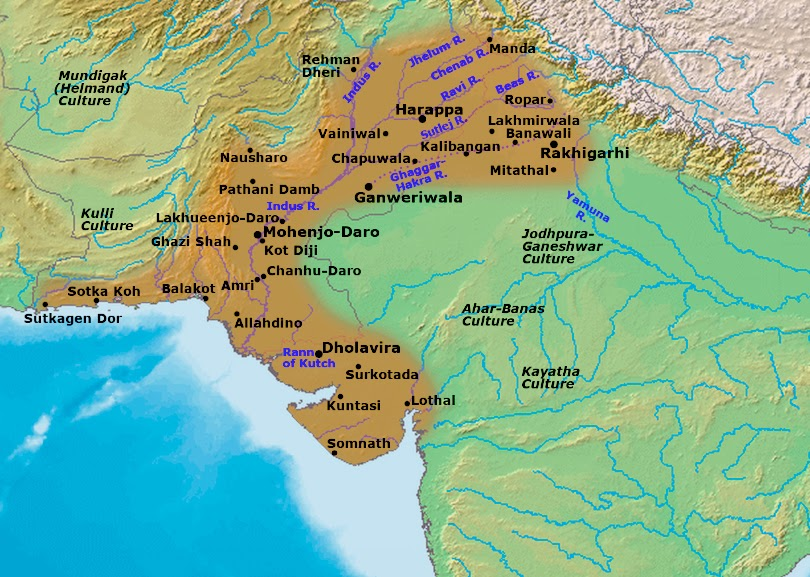Important Facts For Prelims
National Maritime Heritage Complex
- 04 Jul 2023
- 6 min read
Why in News?
Recently, Union Minister of Ports, Shipping and Waterways, reviewed the project process of National Maritime Heritage Complex (NMHC), Lothal in Gandhinagar, Gujarat.
- NMHC complex will have Asia’s Biggest Under Water Marine Museum and India’s Grandest Naval Museum.
What is the National Maritime Heritage Complex?
- About:
- The NMHC is being constructed at the historic Indus Valley civilization region of Lothal, Gujarat, under the Ministry of Ports, Shipping, and Waterways.
- Its primary objective is to showcase the maritime heritage of India from ancient to modern times, utilizing an edutainment approach and incorporating the latest technology.
- Significance:
- The NMHC is set to become the world's largest maritime museum complex and an international tourist destination.
- It will play a crucial role in educating visitors about India's rich maritime history and elevate India's image in the global maritime sector.
- The project is part of the Sagarmala Programme and is being developed with the participation of public and private institutes, organizations, and corporate social responsibility (CSR) initiatives. Major ports in India have also contributed funds to support the project.
- Unique Features of NMHC:
- Includes Lothal Mini Recreation; Four theme parks: Memorial, Maritime and Navy, Climate, and Adventure and Amusement; Coastal States Pavilion.
What is Lothal?
- About:
- One of the southernmost sites of the IVC in Gujarat's Bhāl region. Believed to have been built around 2,200 BC.
- It flourished as a trade center around 2,200 BC, with trade connections reaching West Asia and Africa.
- Known for its trade of beads, gems, and ornaments.
- Meaning of "Lothal" in Gujarati is "the mound of the dead."
- The excavated site of Lothal is the only port town of the Indus Valley Civilization.
- Nomination for UNESCO World Heritage Site:
- Lothal was nominated in April 2014 for inclusion on the UNESCO World Heritage List.
- Its application is pending on the tentative list of UNESCO.
UPSC Civil Services Examination Previous Year Question (PYQ)
Prelims
Q1. Which one of the following ancient towns is wellknown for its elaborate system of water harvesting and management by building a series of dams and channelizing water into connected reservoirs? (2021)
(a) Dholavira
(b) Kalibangan
(c) Rakhigarhi
(d) Ropar
Ans: (a)
Exp:
- The city of Dholavira was located on Khadir Beyt in the Rann of Kutch, where there was fresh water and fertile soil. Unlike some of the other Harappan cities, which were divided into two parts, Dholavira was divided into three parts, and each part was surrounded with massive stone walls, with entrances through gateways.
- There was also a large open area in the settlement, where public ceremonies could be held. Other finds include large letters of the Harappan script that were carved out of white stone and perhaps inlaid in wood. This is a unique find as generally Harappan writing has been found on small objects such as seals.
- Being the 6th largest of more than 1,000 Harappan sites discovered so far, and occupied for over 1,500 years, Dholavira not only witnesses the entire trajectory of the rise and fall of this early civilization of humankind, but also demonstrates its multifaceted achievements in terms of urban planning, construction techniques, water management, social governance and development, art, manufacturing, trading, and belief system.
- With extremely rich artefacts, the well-preserved urban settlement of Dholavira depicts a vivid picture of a regional centre with its distinct characteristics, that also contributes significantly to the existing knowledge of Harappan Civilization as a whole.
- Therefore, option (a) is the correct answer.
Q2. Which of the following characterizes/characterize the people of Indus Civilization? (2013)
- They possessed great palaces and temples.
- They worshipped both male and female deities.
- They employed horse-drawn chariots in warfare.
Select the correct statement/statements using the codes given below:
(a) 1 and 2 only
(b) 2 only
(c) 1, 2 and 3
(d) None of the statements given above is correct
Ans: (b)
Q3. Which one of the following is not a Harappan site? (2019)
(a) Chanhudaro
(b) Kot Diji
(c) Sohgaura
(d) Desalpur
Ans: (c)
Exp:
- Kot Diji (now in the Sindh region of Pakistan) was an early Harappan site on the east bank of the Indus river and was excavated between 1955 and 1957.
- Chanhudaro in Pakistan and Desalpur in Gujarat are mature Harappan sites.
- Sohgaura in Gorakhpur, Uttar Pradesh, is known for Sohgaura copper plate inscription which is considered to be from the Mauryan period. It is not a Harappan site.
- Therefore, option (c) is the correct answer.







